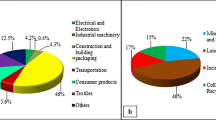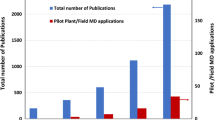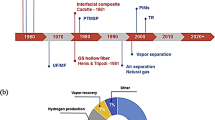Abstract
Newly, Pebax polymer (pure and composite polyether block amide) has been extensively applied for CO2 elimination from air contaminants. The Pebax involves of polyamide (PA) and stretchy polyether (PEO) portions, which can suggest excellent solubility as well as bulk-free fractional volume for CO2 permeation. In the present work, the polymeric nanocomposite membranes (Pebax/PEG/NCS) were synthesized by adding different amount of nanochitosan particles (NCS) and polyethylene glycol (PEG) to the Pebax with applying Taguchi’s experimental design with Minitab software as well as using thermal phase separation method. The input variables to the software included 4 factors at 4 levels, namely wt% of PEG, wt% of NCS, temperature (°C), and pressure (bar) in the ranges of (0, 20, 30, 40), (0, 10, 20, 30), (30, 35, 40, 45), and (4, 6, 8, 10), respectively. The Taguchi method yielded 16 optimal test arrays, each with different conditions. The morphology and structure of NCS and synthesized membranes, Pebax/PEG/NCS, were studied using infrared spectroscopy (FT-IR), X-ray diffraction (XRD), and field emission scanning electron microscopy (FE-SEM) tests. Their thermal properties were analyzed using thermal gravity analysis (TGA) and differential scanning calorimetry (DSC) tests. The effect of NCS amount, polymer concentration, temperature, and pressure on the performance of the Pebax/PEG/NCS was then studied. Lastly, the permeability of the constructed membranes was measured using the constant pressure-variable volume method. The first result of the present work indicated that the permeability of CO2 was higher than N2 gas due to its non-polarity and determinability. The second result obtained is that the increase of NCS increases the permeability and selectivity of N2 and CO2 gases. The third result showed that in the gas permeation test in Pebax/PEG/NCS, the maximum permeability of CO2 was from the B15 test with a value of 281.111 barrer, and the maximum permeability for N2 gas from the B14 has a permeability of 17.477 barrer at a temperature of 35 °C and a pressure of 10 bar. The obtained results are in good agreement with the literature.
















Similar content being viewed by others
References
Khan AL, Li X, Vankelecoma IF (2011) Mixed-gas CO2/CH4 and CO2/N2 separation with sulfonated PEEK membranes. J Memb Sci 372:87–96
Kosinov N, Gascon J, Kapteijn F, Hensen EJM (2016) Recent developments in zeolite membranes for gas separation. J Membr Sci 499:65–79
Cardoso ART, Ambrosi A, Di Luccio M, Hotza D (2022) Membranes for separation of CO2/CH4 at harsh conditions. J Nat Gas Sci Eng 98:104388
Ameri E, Sadeghi M, Zarei N, Pournaghshband A (2015) Enhancement of the gas separation properties of polyurethane membranes by alumina nanoparticles. J Membr Sci 479:11–19
Shameli A, Ameri E (2016) Synthesis of cross-linked PVA membranes embedded with multiwall carbon nanotubes and their application to esterification of acetic acid with methanol. Chem Eng J. https://doi.org/10.1016/j.cej.2016.10.039
Izumi Y, Iizuka A, Ho H-JJJCP (2021) Calculation of greenhouse gas emissions for a carbon recycling system using mineral carbon capture and utilization technology in the cement industry. J Cleaner Prod 312:127618
Noshadi M, Ghotbizadeh M (2017) Determination of atrazine isotherms on agricultural soils. Int J Environ Sci Technol 14:1285–1290
Tamiji T, Ameri E (2017) Preparation, characterization, and gas permeation properties of blend membranes of polysulfone and polyethylene glycol inclusive alumina nanoparticles. Int J Environ Sci Technol. https://doi.org/10.1007/s13762-016-1238-2
Akbarian I, Fakhar A, Ameri E, Sadeghi M (2018) Gas-separation behavior of poly (ether sulfone)–poly (ethylene glycol) blend membranes. J Appl Polym Sci. https://doi.org/10.1002/APP.46845
Ghaemi N, Daraei P, Akhlaghi FS (2018) Polyethersulfone nanofiltration membrane-embedded by chitosan nanoparticles: fabrication, characterization, and performance in nitrate removal from water Carbohydr polym 191:142–151
Mousavi SR, Asghari M, Mahmoodi NM (2020) Chitosan-wrapped multiwalled carbon nanotube as filler within PEBAX thin film nanocomposite (TFN) membrane to improve dye removal. Carbohydr Polym. https://doi.org/10.1016/j.carbpol.2020.116128
Liang Y, Li J, Xue Y, Tan T, Jiang Z, He Y, Shangguan W, Yang J, Pan Y (2021) Benzene decomposition by non-thermal plasma: a detailed mechanism study by synchrotron radiation photoionization mass spectrometry and theoretical calculations. J Hazard Mat 420:126584. https://doi.org/10.1016/j.jhazmat.2021.126584
Lin X, Lu K, Hardison AK, Liu Z, Xu X, Gao D, Gong J, Gardner WS (2021) Membrane inlet mass spectrometry method (REOX/MIMS) to measure 15 N-nitrate in isotope-enrichment experiments. Ecol Ind 126:107639
Dai Z, Ma Z, Zhang X, Chen J, Ershadnia R, Luan X, Soltanian MR (2022) An integrated experimental design framework for optimizing solute transport monitoring locations in heterogeneous sedimentary media. J Hydrology 614:128541
Yang Z, Xu J, Yang L, Zhang X (2022) Optimized dynamic monitoring and quality management system for post-harvest matsutake of different preservation packaging in cold chain Foods 11(17):2646. https://doi.org/10.3390/foods11172646
Sanni SE, Vershima DA, Okoro EE, Oni BA (2022) Technological advancements in the use of ionic liquid- membrane systems for CO2 capture from biogas/flue gas -. Rev Heliyon 8:e12233
Chen PB, Yang JW, Rao ZX, Wang Q, Tang HT, Pan YM, Liang Y (2023) Efficient in-situ conversion of low-concentration carbon dioxide in exhaust gas using silver nanoparticles in N-heterocyclic carbene polymer. J Colloid Interf Sci 652:866–877
Wang Y, Zhai W, Li J, Liu H, Li C, Li J (2023) Friction behavior of biodegradable electrospun polyester nanofibrous membranes. Tribology Int 188:108891
Feng X, Wang B, Gao G, Gao S, Xie C, Shi JW (2023) MnyCo3–yOx bimetallic oxide prepared by ultrasonic technology for significantly improved catalytic performance in the reduction of NOx with NH3. Fuel 352:129159
Bahreini H, Ameri E, Dehaghani HA (2024) Effect of incorporation of multi-walled carbon nanotubes on the CO2/CH4 separation performance of sulfonated poly (ether ketone) / polyetherimide composite membranes using design of experiments and molecular dynamics simulation methods. Arab J Chemis 17:105400
Ho H-J, Iizuka A, Shibata EJI, Research EC (2019) Carbon capture and utilization technology without carbon dioxide purification and pressurization: a review on its necessity and available technologies Ind Eng Chem Res 58(21):8941–8954
Donelian A, de Oliveira PF, Rodrigues AE, Mata VG, RAJTJoSF M (2016) Performance of reverse osmosis and nanofiltration membranes in the fractionation and retention of patchouli essential oil. J Supercrit Fluids 107:639–648
Shahid S, Nijmeijer K (2014) Performance and plasticization behavior of polymer–MOF membranes for gas separation at elevated pressures. J Membr Sci 470:166–177
Quader MA, Ahmed S, Ghazilla RAR, Ahmed S, Dahari M (2015) A comprehensive review on energy efficient CO2 breakthrough technologies for sustainable green iron and steel manufacturing renewable and. Sustainable Ener Rev 50:594–614
Jameh AA, Mohammadi T, Bakhtiari O (2020) Preparation of PEBAX-1074/modified ZIF-8 nanoparticles mixed matrix membranes for CO2 removal from natural gas. Sep Purif Techn 231:115900
Rosli A, Shoparwe NF, Ahmad AL, Low SC, Lim JK (2019) Dynamic modeling and experimental validation of CO2 removal using hydrophobic membrane contactor with different types of absorbent. Sep Purif Techn 219:230–240
Mutch GA, Qu L, Triantafyllou G, Xing W, Fontaine M-L, Metcalfe IS (2019) Supported molten-salt membranes for carbon dioxide permeation. J Mat Chemis A 7(21):12951–12973
Kim S, Scholes CA, Heath DE, Kentish SE (2021) Gas-liquid membrane contactors for carbon dioxide separation: a review. Chem Eng J 411:128468
Kang Z, Fan L, Sun D (2017) Recent advances and challenges of metal–organic framework membranes for gas separation. J Mat Chemis A 5(21):10073–10091
Peng Y, Li Y, Ban Y, Yang W (2017) Two-dimensional metal–organic framework nanosheets for membrane‐based. gas Sep Angew Chem Int Ed Engl 7(33):9757–9761. https://doi.org/10.1002/anie.201703959
Biswal BP, Chaudhari HD, Banerjee R, Kharul UK (2016) Chemically stable covalent organic framework (COF)-Polybenzimidazole hybrid membranes: enhanced gas separation through Pore Modulation. Chem Europ J 22(14):4695–4699. https://doi.org/10.1002/chem.201504836
Kim J, Park T, Chung E (2021) Effect of 2-MeIM/Zn molar ratio on CO2 permeability of Pebax/ZIF-8 mixed matrix membranes. J Membrane Sci Res 7(2):74–84
Meshkat S, Kaliaguine S, Rodrigue D (2020) Comparison between ZIF-67 and ZIF-8 in Pebax® MH-1657 mixed matrix membranes for CO2 separation. Sep Purif Techn 235:116150
Yong WF, Zhang H (2021) Recent advances in polymer blend membranes for gas separation and pervaporation. Progr Mat Sci 16:100713
Jeazet HBT, Staudt C, Janiak C (2012) Metal–organic frameworks in mixed-matrix membranes for gas separation. Dalton Transac 41(46):14003–14027
Taheri P, Maleh MS, Raisi A (2021) Cross-linking of poly (ether-block-amide) by poly (ethylene glycol) diacrylate to prepare plasticizing-resistant CO2-selective membranes. J Environ Chem Eng 9(5):105877
Yu B, Cong H, Li Z, Tang J, Zhao XS (2013) Pebax-1657 nanocomposite membranes incorporated with nanoparticles/colloids/carbon nanotubes for CO2/N2 and CO2/H2 separation. J Appl Polym Sci 130:2867–2876
Isanejad M, Azizi N, Mohammadi T (2017) Pebax membrane for CO2/CH4 separation: effects of various solvents on morphology and performance. J Appl Polym Sci 134:44531
Wang X, Zhang Y, Chen X, Wang Y, He M, Shan Y, Li Y, Zhang F, Chen X, Kita H (2022) Preparation of Pebax1657/MAF-7 mixed matrix membranes with enhanced CO2/N2 separation by active site of Triazole Ligand. Membranes 12:786. https://doi.org/10.3390/membranes12080786
Nobakht D, Abedini R (2022) Improved gas separation performance of pebax®1657 membrane modified by poly-alcoholic compounds. J Environ Chem Eng 10:107568
Zhang Y, Tong Y, Li X, Guo S, Zhang H, Chen X et al (2021) Pebax mixed-matrix membrane with highly dispersed ZIF-8@ CNTs to enhance CO2/N2 separation. ACS omega 6(29):18566–18575
Guan X, Wu Y, Zheng Y, Zhang B (2023) Improved CO2/N2 separation performance of Pebax-1074 blend membranes containing poly (ethylene glycol). Sci Progr 106(1):00368504231156295
Wong E, Jawad Z, Chin B, Wee S (2018) A kinetic study of CO2 sorption improvement in the CA-CNTs mixed matrix membrane. IOP Conf Ser: Mat Sci Eng IOP Publ 458:012066
Dong G, Hou J, Wang J, Zhang Y, Chen V, Liu J (2016) Enhanced CO2/N2 separation by porous reduced graphene oxide/pebax mixed matrix membranes. J Membr Sci 520:860–868
Alghuthaymi MA, Diab AM, Elzahy AF, Mazrou KE, Tayel AA, Moussa SH (2021) Green biosynthesized selenium nanoparticles by cinnamon extract and their antimicrobial activity and application as edible coatings with nano-chitosan. J Food Qual 2021:1–10
Habibzare S, Asghari M, Djirsarai A (2014) Nano composite PEBAX®/PEG membranes: Effect of MWNT filler on CO2/CH4 separation. Int J Nano Dimen 5:247–254
Rahman MM, Filiz V, Shishatskiy S (2013) PEBAX® with PEG functionalized POSS as nanocomposite membranes for CO2 separation. J Membr Sci 437:286–297
Feng S, Ren J, Hua K et al (2013) Poly(amide-12-b-ethylene oxide)/polyethylene glycol blend membranes for carbon dioxide separation. Sep Purif Technol 116:25–34
Aghaei Z, Naji L, Asl VH, Khanbabaei G, Dezhagah F (2018) The influence of fumed silica content and particle size in poly (amide 6-b-ethylene oxide) mixed matrix membranes for gas separation. Sep Purif Technol 199:47–56
Zhang H, Guo R, Hou J, Wei Z, Li X (2016) Mixed-matrix membranes containing carbon nanotubes composite with hydrogel for efficient CO2 separation. ACS Appl Mater Interfaces 8:29044–29051
Shen J, Liu G, Huang K, Jin W, Lee KR, Xu N (2015) Membranes with fast and selective gas-transport channels of laminar graphene oxide for efficient CO2. Capture Angew Chem 127:588–592
Meshkat S, Kaliaguine S, Rodrigue D (2018) Mixed matrix membranes based on amine and non-amine MIL-53(Al) in pebax (R) MH-1657 for CO2 separation. Sep Purif Technol 200:177–190
Ding R, Dai Y, Zheng W, Li X, Yan X, Li Y, Ruan X, Li S, Yang X, Yang K (2021) Vesicles-shaped MOF-based mixed matrix membranes with intensified interfacial affinity and CO2 transport freeway. Chem Eng J 414:128807
Ashraf MA, Peng W, Zare Y, Rhee KY (2018) Effects of size and aggregation/agglomeration of nanoparticles on the interfacial/interphase properties and tensile strength of polymer nanocomposites. Nanoscale Res Lett 13:214. https://doi.org/10.1186/s11671-018-2624-0
Li M, Zhang X, Zeng S, bai L, Gao H, Deng J, Yang Q, Zhang S (2017) Pebax-based composite membranes with high gas transport properties enhanced by ionic liquids for CO2 separation. RSC Adv 7:6422
Zamora-Mora V, Fernández-Gutiérrez M, Román JS, Goya G, Hernández R, Mijangos C (2014) Magnetic core–shell chitosan nanoparticles: Rheological characterization and hyperthermia application. Carbohydr Polym 102:691–698
Castro-Landinez JF, Salcedo-Galan F, Medina-Perilla JA (2021) Polypropylene/ ethylene—and polar—monomer-based copolymers/montmorillonite nanocomposites: morphology, mechanical properties, and. Oxygen Permeability Polym 13(5):705
Sanaeepur A, Ahmadi R, Amooghin AE, Ghanbari D (2018) A novel ternary mixed matrix membrane containing glycerol-modified poly(ether-block-amide) (Pebax1657)/copper nanoparticles for CO2 separation. J Membr Sci. https://doi.org/10.1016/j.memsci.2018.12.012
Yoon SS, Lee HK, Hong SR (2021) CO2/N2 gas separation using Pebax/ZIF-7—PSf composite membranes. Membranes 11:708
Acknowledgments
The authors thank Semnan University for supporting this article with (Grant No. 97017837).
Funding
This work was supported by the Researchers Program through Semnan University (Grant No. 97017837).
Author information
Authors and Affiliations
Contributions
F.B and M.D expriment and prepared figures M.J supervision. H.A wrote the main manuscript text.
Corresponding authors
Ethics declarations
Conflict of interest
The authors declare that they have no known competing financial interests.
Additional information
Publisher’s Note
Springer Nature remains neutral with regard to jurisdictional claims in published maps and institutional affiliations.
Supplementary Information
Below is the link to the electronic supplementary material.
Rights and permissions
Springer Nature or its licensor (e.g. a society or other partner) holds exclusive rights to this article under a publishing agreement with the author(s) or other rightsholder(s); author self-archiving of the accepted manuscript version of this article is solely governed by the terms of such publishing agreement and applicable law.
About this article
Cite this article
Delavari, M., Beyranvand, F., Jahangiri, M. et al. Increasing the Permeability of Carbon Dioxide and Nitrogen Gases Through a Polymer Membrane Consisting of a Modified Polyether Block Amide and Experimental Design. J Polym Environ (2024). https://doi.org/10.1007/s10924-024-03247-z
Accepted:
Published:
DOI: https://doi.org/10.1007/s10924-024-03247-z




